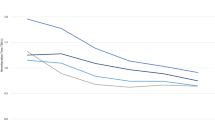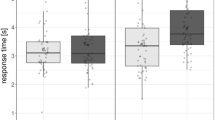Abstract
Twenty-eight children identified with attention deficits and a comparison group of children without ADD were asked to judge the loudness of speech as comfortable (MCL) or tolerable (TL). Results indicated that children with attention deficits required a softer level to make both of these loudness judgements. Children with ADD had statistically signficant differences in their choices of comfort levels (MCL=51 dBHL) and choices of tolerance levels (TL=95 dBHL) from their peers without ADD (MCL=59 dBHL, TL=100 dBHL). These findings are viewed in relation to perceptual differences between children with and without ADD. Additionally, implications for classroom management are discussed.
Similar content being viewed by others
References
Hiscock M, Kinsbourne M, Caplan B, Swanson JM: Auditory attention in hyperactive children: Effects of stimulant medication on dichotic listening performance.J Abnorm Psychol 88(1): 27–32, 1979.
Gascon G, Johnson R, Burd L: Central auditory processing and attention deficit disorders.J Child Neuro 1: 27–33, 1986.
Beitchman JH, Hood J, Rochon J, Peterson M: Empirical classification of speech/language impairment in children II: Behavioral characteristics.Am Acad Child Adol Psychiat J 28(1): 118–123, 1989.
Keith RW, Rudy J, Donahue PA, Kathbamna B: Comparison of SCAN results with other auditory and language measures in a clinical population.Ear and Hearing 10 (6): 382–386, 1989.
Halperin JM, Newcorn JH, Sharma V, Healey JM, Wolf LE, Pascualvaca, DM, Schwartz S: Inattentive and noninattentive ADHD children: Do they constitute a unitary group?J Abnorm Child Psychol 18 (4): 437–449, 1990.
Blackman JA, Westervelt VD, Stevenson R, Welch A: Management of preschool children with attention deficit-hyperactivity disorder.Topics in Early Child Spec Ed 11 (2): 91–104, 1991.
Cantwell DP, Baker L: Association between attention deficit-hyperactivity disorder and learning disorders.J Learn Dis 24: 88–95, 1991.
Dalebout SD, Nelson NW, Hletko PJ: Selective auditory attention and children with attention-deficit hyperactivity disorder: Effects of repeated measurement with and without methylphenidate.Lang Speech Hearing Serv in Schools 22: 219–227, 1991.
Keith RW, Engineer P: Effects of methytphenidate on the auditory processing abilities of children with attention deficit-hyperactivity disorder.J Learn Dis 24 (10): 630–636, 1991.
Lavin P: The counselor as consultant-coordinator for children with attention deficit hyperactivity disorder.Element Sch Guid Counsel 26: 115–120, 1991.
Pearson DA, Lane DM, Swanson JM: Auditory attention switching in hyperactive children.J Abnorm Child Psychol 19 (4): 479–492, 1991.
Keller WD: Auditory processing disorder or attention deficit disorder? InCentral Auditory Processing: A Transdisciplinary View (eds.) Katz J, Stecker NA, Henderson D. St. Louis, MO: Mosby Year Book, 1992.
Zentall S, Shaw J: Effects of classroom noise on performance and activity of secondgrade hyperactivity and control children.J Ed Psychol 72 (6): 830–840, 1980.
Prior M, Sanson A, Freethy C, Geffen G: Auditory attentional abilities in hyperactive children.J Child Psychol Psychiatr 26 (2): 289–304, 1985.
Love AJ, Thompson MGG: Language disorders and attention deficit disorders in young children referred for psychiatric services: Analysis of prevalence and a conceptual synthesis.Am J Orthopsychiatr 58: 52–64, 1988.
American Psychiatric Association:Diagnostic and Statistical Manual of Mental Disorders (3rd Edition), DSM-III Revised, Washington, D.C., 1987.
Martin F:Introduction to Audiology (5th Edition). Englewood Cliffs, NJ: Prentice-Hall, 1994.
Nan der Meere J, Sergeant J: A divided attention experiment with pervasively hyperactive children.J Abnorm Child Psychol 15 (3): 379–392, 1987.
Schachar R, Logan G: Are hyperactive children deficient in attentional capacity?J Abnorm Child Psychol 18 (5): 493–513, 1990.
Author information
Authors and Affiliations
Additional information
Parent and Child Consultation Service
Rights and permissions
About this article
Cite this article
Lucker, J.R., Geffner, D. & Koch, W. Perception of loudness in children with ADD and without ADD. Child Psych Hum Dev 26, 181–190 (1996). https://doi.org/10.1007/BF02353359
Received:
Revised:
Accepted:
Issue Date:
DOI: https://doi.org/10.1007/BF02353359




